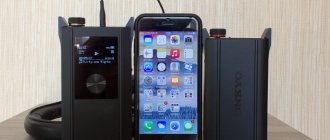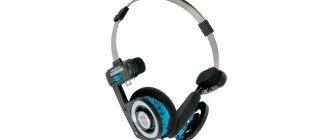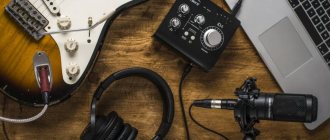The purpose of a headphone amplifier is to do three things: make the signal louder, improve its quality, and prevent distortion.
Amplifiers are usually divided into transistor, tube and hybrid - when the design contains both a tube and a transistor stage.
From a listening perspective, the differences are:
- Transistor amplifiers, due to their circuitry, do not color the sound and do not give it additional character. This is more of an advantage in studio work, and if the amplifier serves as a reference amplifier, but hi-fi lovers may need sound character.
- Transistor amplifiers do not heat up during operation and consume less current.
- Tubes are in most cases used to amplify the signal to low-impedance headphones.
- An important subjective point - lamps have their own aesthetics. They not only color the sound, but also visually make an impression on the listener. And this is important if you do not use the amplifier for work tasks.
When is an amplifier worth buying?
Firstly, when you want to improve the sound quality, for example from portable devices. Built-in digital to analog converters will not produce reference quality sound.
Secondly, when such a headphone parameter as impedance (resistance) comes into play.
You can understand whether an amplifier is needed or not by looking at the resistance of the headphones in Ohms.
Low impedance headphones can be safely used without external amplification. Any phones, laptops and tablets can handle “boosting” these headphones.
Another thing is high-impedance headphones, which include, for example, many studio solutions. High impedance requires more voltage to play music at the same volume as low impedance. And to make a large membrane sound, you may also need an amplifier.
Without it, the power may not be enough, the sound will be quieter, and the frequency response will be distorted in some areas.
For simplicity, we can consider high-impedance headphones to be those full-size models with an impedance above 100 Ohms, and in-ear headphones with an impedance of more than 32 Ohms.
VOLUME2
Volume2 is a simple program that is used as an alternative to the standard Windows volume control. The utility is distributed free of charge, the interface has been translated into Russian.
After launch, the program will move to the system tray. When you click on the utility icon in the tray, a classic regulator with volume, balance settings and a mute function will open.
By right-clicking on the application icon, additional functions will become available:
- Turn sound on and off.
- Select the default playback device: speakers, headphones, microphone.
- Manage connected devices.
- Making changes to the volume mixer.
- Setting up playback devices.
- Turn on the peak audio level indicator.
- Disabling Volume2.
In the General settings section of the program, users can change the device to control, change the volume of an individual application or the entire system, select an alternative device, etc.
- "Screen indicator". Here you can enable or disable the indicator, as well as change its style and placement on the screen.
- “System tray” - in this section the function of changing the program indicator icon in the tray of the Windows operating system is available.
- In the “Mouse Events” section there are settings for changing the format of how the program works with the mouse: changing functions when you click on the left and right button, setting new capabilities for the wheel, etc.
- “Edge Control” - in this section of options you can enable the volume control function at the edge of the screen.
- "Hotkeys". Here users can set hotkeys to quickly control the program.
- "System". Here the system settings of the Volume2 application are made: launching the utility along with Windows OS, enabling notifications, etc.
- "Schedule". In this section, you can enable a schedule for performing various actions: increasing or decreasing the volume, launching a program, etc. To do this, you need to specify the date, time and number of repetitions of the selected action.
- In the “Interface language” section you can change the program language.
We also recommend that you study the list of programs for enhancing sound on a Windows computer.
How to choose
Pay attention to power. For headphones, it is important that they receive enough both voltage and current. Basically, high-impedance headphones need more voltage and low-impedance headphones need more current.
Regarding voltage, the so-called one-eighth rule applies: the output impedance from the amplifier should be less than ⅛ of the impedance of the headphones. That is, if for headphones with an impedance of 32 Ohms, the output impedance should be 4 Ohms.
In addition, the following rule applies: the lower the sensitivity of the headphones, the more output power is required.
In order not to estimate the power of your potential purchase based on the characteristics of the headphones, you can use the digiZoid service.
In this top we have collected examples of high-quality devices based on the tasks for which they are best suited.
Let's sum it up
Headphone preamps should be considered in direct proportion to the type of headphones you use. Most often, studios use both types of headphones - high-impedance and low-impedance. Accordingly, we need equipment that will allow us to connect both types, without visible differences in sound.
The preamplifier will also be an excellent purchase for studios where you need to record several people live at once or create various monitor mixes. The preamplifier will provide sound amplification without loss of power, even with high-impedance studio headphones.
When choosing a headphone preamp, proceed from your real needs, the main of which, of course, will be the number of channels.
Take care of your ears, loud is not good. Good luck in job.
Author of the article: Albert Safronov, Pop-Music
For home and work
Audioquest DragonFly Red. Strictly speaking, this pocket device is a digital-to-analog converter. But it can also be used with high-impedance headphones as an amplifier. The device is universal, works with computers on Win and Mac, and phones on iOS and Android. DragonFly can cut out interference and smoothes out distortions in data transmission.
Pros:
- The device is the size of a flash drive;
- Suitable for any phone and any computer;
- Jitter and interference are leveled out.
For lamp lovers
Cayin HA-1AMK2 is a lamp device in the mid-price segment. It is good because it is equipped with two headphone outputs and a switchable output voltage: a choice of 32, 64, 150, 300 and 600 Ohms. At the output, depending on the selected connector, the sound is slightly different.
This is not a studio solution, since the sound is noticeably colored by the lamps. But in a high-quality home system, the amplifier performs well, and its appearance helps create an atmosphere for thoughtful listening.
Pros:
- Design;
- Two headphone outputs;
- Adjustable impedance.
SOUND BOOSTER
Sound Booster is a functional and simple utility for adjusting the sound of the operating system. The program is compatible with Windows and supports the Russian language.
Three types of license are available:
- Initial. The license fee is $20. Users receive 1 year of developer support and the ability to work on one PC.
- Standard. The license price is $35. The utility can work on three computers. Technical support - 2 years.
- Professional. The cost of the professional version of the software is $50. Supports work on five computers simultaneously. Users receive support and free updates for 2 years.
After launching the utility, it will move to the operating system tray. When you click on the icon, a small volume control window will open. Maximum sound amplification is 500%.
To open the Sound Booster settings menu, you need to right-click on the program icon in the tray and select the appropriate section.
The following functions are available in the settings:
- Change the interface language. The default is Russian. English and Portuguese are available to choose from.
- Assigning hotkeys to quickly increase and decrease volume.
- Setting the startup gain level. The maximum allowed level is 500.
- Additional settings: launch the utility when Windows starts, enable or disable notifications, automatically check for updates, fix compatibility problems.
In the program options menu you can change the operating mode: interception, interception and APO effect, APO effect, Super Gain. Each of these parameters changes the quality and volume of the sound from your speakers or headphones. You can activate several modes at the same time.
The Super Gain function is not suitable for budget speaker systems. It is necessary to use this mode on professional equipment, as the instrument increases the amount of bass, low and high frequencies.
For a professional studio
Rupert Neve Design RNHP is a studio transistor component from the legendary brand.
Balanced line-level, unbalanced RCA and 3.5 mm inputs are available. RNHP is a reference amplifier and transmits the purest and most uncolored sound across the entire spectrum of audible frequencies. Suitable for mixing compositions and other work on the track.
Pros:
- Detailed and uncolored sound picture;
- Big headroom;
- Build quality;
- Several switching options;
- Does not overheat and does not require breaks in operation.
About the audience
At the moment, in relation to this class of equipment, the contingent of buyers can be divided into three main groups: 1. Those who know nothing about headphone preamplifiers and, accordingly, do not use them.
These are the majority. 2. Militant Hi-Fi and Hi-End people who foam at the mouth to prove that “each headphone needs to be matched with its own amplifier”, “the wires should only be made of gold, as thick as your arm, and you... well, you... don’t understand anything at all”! Usually they talk about custom models with exorbitant prices.
3. Professionals. Use headphones for work. There is no debate about preamps at all. Connect the headphones either to the mixing console or directly to the sound card. Everyone is happy.
For Hi-End systems
Sennheiser HDV 820 is a premium amplifier/DAC. Features balanced XLR and unbalanced RCA inputs, XLR3, XLR4, 6.3 mm and 4.4 mm Pentaconn outputs. The ESS 9028PRO SABER chip is responsible for converting the digital signal to analog. The amplifier has enough power to play DSD256 files with a frequency of 12.3 MHz and PCM 32 bit/384 kHz files.
Pros:
- Exceptional quality;
- Premium components;
- Ability to reproduce the highest sampling rates;
- Balanced inputs.
Once again briefly about the important
- We are interested in impedance at the headphones and at the signal source. If the impedances match each other, there will be good sound and a wide range of volume.
- The headphone impedance needs to be eight times higher than the source impedance. This is called the one-eighth rule. If the impedances are the same or the headphones have a lower impedance, the sound quality will be poor.
- Consider the sensitivity of the headphones. Headphones with high sensitivity (100 dB and above) and low impedance (8-32 ohms) usually work well with phones and players and will not particularly benefit from a separate amplifier. Less sensitive (up to 95 dB) and/or high-impedance (more than 50 Ohms) will benefit in sound when working with an amplifier.
- High impedance headphones need more voltage, and low impedance headphones need more current (tube amps may not be suitable).
- High impedance alone does not mean better sound quality.
AUDIO AMPLIFIER
Audio Amplifier is a simple utility for working with the sound of a single file on your computer. The main advantage of the program is the interface, designed in a minimalist style. The application window contains several important buttons for making settings.
Audio Amplifier is available for the Windows operating system (32 and 64 bit). The interface is translated only into English, but the software is distributed absolutely free.
The main difference between the utility and similar solutions is that it works with individual media files, and not the overall system sound settings. To get started, you need to load an audio file or video into the program by clicking the corresponding button in the main window.
Information about the downloaded file will be displayed in the window under the button: name, format, size, duration, bitrate, etc.
On the right side of the interface there is a volume control. To adjust the sound (increase or decrease the volume), you need to turn the knob or use the arrows under the current volume indicator line. The maximum allowable value for gain is 1000%.
To apply the set volume value to the selected file, you must click the “Amplify” button and select a folder to save the source media file.











